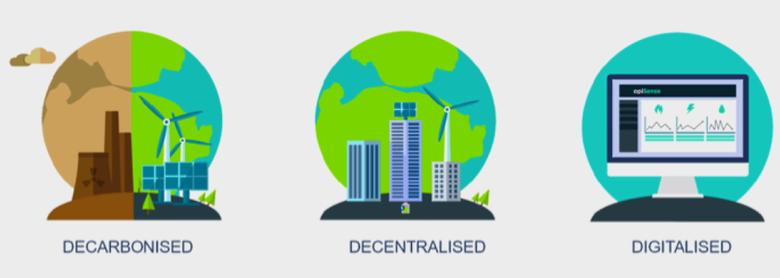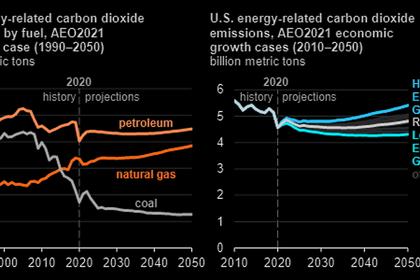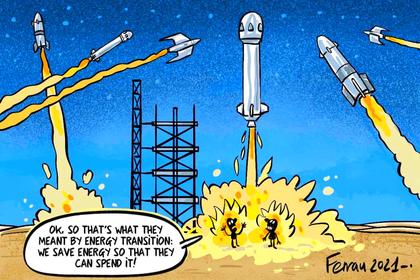
GLOBAL 3D ENERGY MEGATRENDS

By CLAUS VETTER
Global Product Group Manager, Automation and Communication, Grid Automation BU Hitachi Energy
ENERGYCENTRAL - Aug 23, 2022 - The transformation of the electricity system is buoyed by three key megatrends: decarbonization, decentralization, and digitalization. Together, these primary trends, the so-called ‘3Ds’, are ushering in a new era of the electricity system by converging to produce game-changing disruptions and fundamentally reshaping the electricity system.
Support for decarbonization to combat climate change has gained traction in recent years in response to shifts in public opinion combined with regional, national and international policy actions and key technological advances in renewable energy, electric vehicles, and battery storage.
The drive towards decarbonization could entail significant challenges for distribution grids due to the anticipated uptake of distributed, variable renewable energy sources (V-RES) and electric vehicles (EVs) connecting and disconnecting to the grid at random hours during the day.
Decentralization: Traditional electric utility models are based on centralized power generation with a unidirectional flow of electricity from the plant to the user. Modern utilities are increasingly adopting decentralized models that allow power to flow onto the grid from many points or nodes, mainly from V-RES sources such as wind and solar, battery energy storage systems (BESS), and microgrids.
These models require the grid to be capable of accommodating multi-directional, unpredictable electricity flows, which adds to the complexity of grid management.
The rapid improvement rates and a sharp decrease in the costs of the underlying technologies such as photovoltaic (PV) are accelerating decentralization and changing the way energy is being generated, transported, and consumed. Utility- and smaller-scale BESSs connected to the distribution grid make the grid more efficient by discharging at times of high demand and charging at times of over-supply
Digitalization: Thanks to the confluence of favorable technological advancements and market developments, utilities can now transform their business processes by an end-to-end sharing of information across the entire enterprise, improving operations and effectiveness of customer delivery. In a quest to remain competitive in a rapidly changing environment, utilities are increasingly adopting digital technologies like machine learning (ML), artificial intelligence (AI) and virtual or augmented reality (VR/AR), cloud and analytics, 5G, and blockchain. Once integrated, these technologies can provide a host of new insights that can help utilities sharpen their competitive edge.
These new digital technologies allow data from sensors at substations, smart metering systems, and other connected devices to be collected and delivered to the control room via wired and wireless broadband communication networks. The data can then be processed by applications powered by AI that provide operators with detailed views of their grid, enabling fast, accurate decision-making. And when the field workforce is equipped with digital devices that provide mobile access to maps, data, work-management tools, and real-time expertise, this results in increased workforce productivity, which in turn can aid utilities to better serve their customers. The application of digital productivity tools and automation of the various processes ultimately translates into immediate and substantial improvements to the bottom line of the utility company. For example, digital tools that enable sophisticated workforce management can streamline operations and substantially reduce OPEX.
Grid modernization drivers from the utility perspective
The general trend toward grid modernization is driven largely by new digital capabilities and the promise of automation that will enhance grid control and stability and improve decision-making, safety, security, sustainability, and reliability.
Digital technologies can also be used to meet rapidly evolving customer expectations, enhance reliability and security and enable broad integration of Distributed Energy Resources (DER). Whilst all of these elements of grid modernization are attractive, the main drivers for grid modernization from a utility’s point of view include reliability/resiliency, efficiency, sustainability, operational effectiveness, and customer engagement.
Reliability and resiliency: Grid modernization is chiefly about ensuring that utility companies will be able to deliver the energy that customers need when they need it with minimal service interruptions. To meet these expectations and guard against the increased frequency and magnitude of outages, utilities are making investments in automation and communications (A&C) systems to harden the grid and improve resiliency. Many of these systems are aimed at proactively managing people and field assets for this purpose.
Efficiency: Electrical system efficiencies result in many benefits including reduced demand during peak loads, improved service quality, reduced losses, efficient integration of DERs, and lower energy consumption through methods like feeder voltage optimization, where automation provides visibility into the real-time conditions of the network to improve power flow.
Sustainability: Utilities are now aiming for a sustainable energy future through the integration of DERs. Production of energy from more sustainable sources can be realized at both utility-scale and distributed resources connected at the residential level.
Sustainability can be achieved by focusing on various aspects like monitoring grid health by deploying low-cost sensors, isolating grid failures and performing quick restoration of power using visualizations and data analysis, strengthening cybersecurity, deploying advanced technologies for power flow control, and real-time validation of electric system restoration activities.
Operational effectiveness: Utilities aim to make use of information technology to arrive at improved situational awareness of grid disturbances, workforce management, and the latest asset conditions. By sharing data and information across the enterprise, utilities can dramatically improve asset performance management and make faster, more accurate decisions.
Customer engagement: Overall, renewable generation and automation are driving us to a new grid paradigm – instead of dispatching generation to match the load, utilities need to be able to manage the load to match renewable generation availability to avoid curtailment. As a result, utilities are moving away from the ‘ratepayer’ mindset, where their customers are strictly consumers and are seeking new ways to become more customer-centric as they modernize grid operations.
Customer engagement includes not only aspects like providing outage notifications with an estimated time for restoration, allowing access to energy usage data, and expanding the options for energy management, but also providing grid management awareness through hardware and software solutions.
The three major stages on the path to becoming a truly digital utility, one of the tenets of grid modernization is creating a pathway to becoming a fully digital enterprise. To effectively modernize to meet regulatory and business challenges and become more resilient, customer-focused, and automated, utilities must progress through three distinct stages: digitization, digitalization, and enterprise integration.
Digitization is the process of converting analog data into digital formats that can be gathered, stored, and processed by a computer. Once digitization occurs, data can be accessed and used in a multitude of new ways and can be combined with other data that can help businesses of all kinds gain new perspectives on their operations. In the energy sector, the data not only becomes more accessible and moves faster but can also work synergistically to provide optimal plant and grid output.
Digitization can be achieved by the addition of certain control systems and software, or even by doing something as simple as replacing the copper cables with fiber optics and thus substituting analog with digital signals. Digitization is a pre-condition for the next stage, digitalization to happen.
Digitalization: This stage shares its name with the megatrend because they both refer to the transformation of business processes by end-to-end sharing of digitized information across the entire enterprise improving operations and effectiveness of customer delivery.
A utility may be considered ‘digitalized’ when data can be captured and communicated autonomously throughout a distributed network. Once digitalized, business velocity can accelerate because systems are more efficient and responsive, which allows innovation to occur more rapidly.
Enterprise integration: The third and final maturity level is enterprise integration. At this level, the optimization of strategic, data-driven decision-making and digital processes are applied to solve business challenges.
Since the integrated analytics and optimized process and systems across the enterprise have been already established in stage 2, the utility will now have a holistic, 360-degree view of the customer that helps in improving delivery, digital communication, and customer experience.
Digitalization and distribution utilities
Along its digitalization journey, the main goal of a utility is to achieve increased visibility of its physical assets, which in turn enables the migration from asset focus to system-level analysis. For instance, instead of the typical whiteboard and spreadsheet-driven data capture process, if smart devices (IEDs, sensors, etc.) are deployed in the field, the data can be quickly captured and transformed via device-level sensing and data acquisition. The operational data would then be transferred to higher levels like the cloud, substation, or the control center via a cost-effective communication architecture where it can be used in new ways.
To enable a higher degree of business agility necessary to optimize asset management, the installed base would be made remote-manageable. As a next step of the utilities, system-wide data integration would offer broad visibility and historical analysis across the fleet, leading to better risk management.
Digital transformation from the field to the boardroom
Digitalization and the resulting transformation of operations affect all components and aspects of a distribution utility. A real-life scenario of a utility’s digital transformation journey encompasses the application of automation at the field level, control room, operations center, and boardroom.
The suggested roadmap pertains to an incremental approach to infrastructure investments, adoption of advanced technologies into the grid, the inclusion of smarter distributed system designs, seamless integration of DERs to improve overall efficiency, comprehensive access across disparate IT/OT systems, and collaboration across data and system silos, converging together to create a resilient and efficient system that also accomplishes economic and environmental objectives.
For example, monitoring equipment can translate information in milliseconds and can automatically communicate that information to decision-making systems at higher levels. This type of comprehensive architecture results in an interconnected, data-driven environment, that enables utilities to make faster decisions, allows for dynamic, real-time grid management, and provides cross-functional visibility.
With these enhancements, utilities can improve asset management, reduce maintenance costs, and can integrate new data streams into their strategic planning. The utilities that adopt an agile, thoughtfully designed digital approach will be better placed to deliver an improved customer experience, enabling them to thrive in this transformative age of digital energy.
Earlier:


















